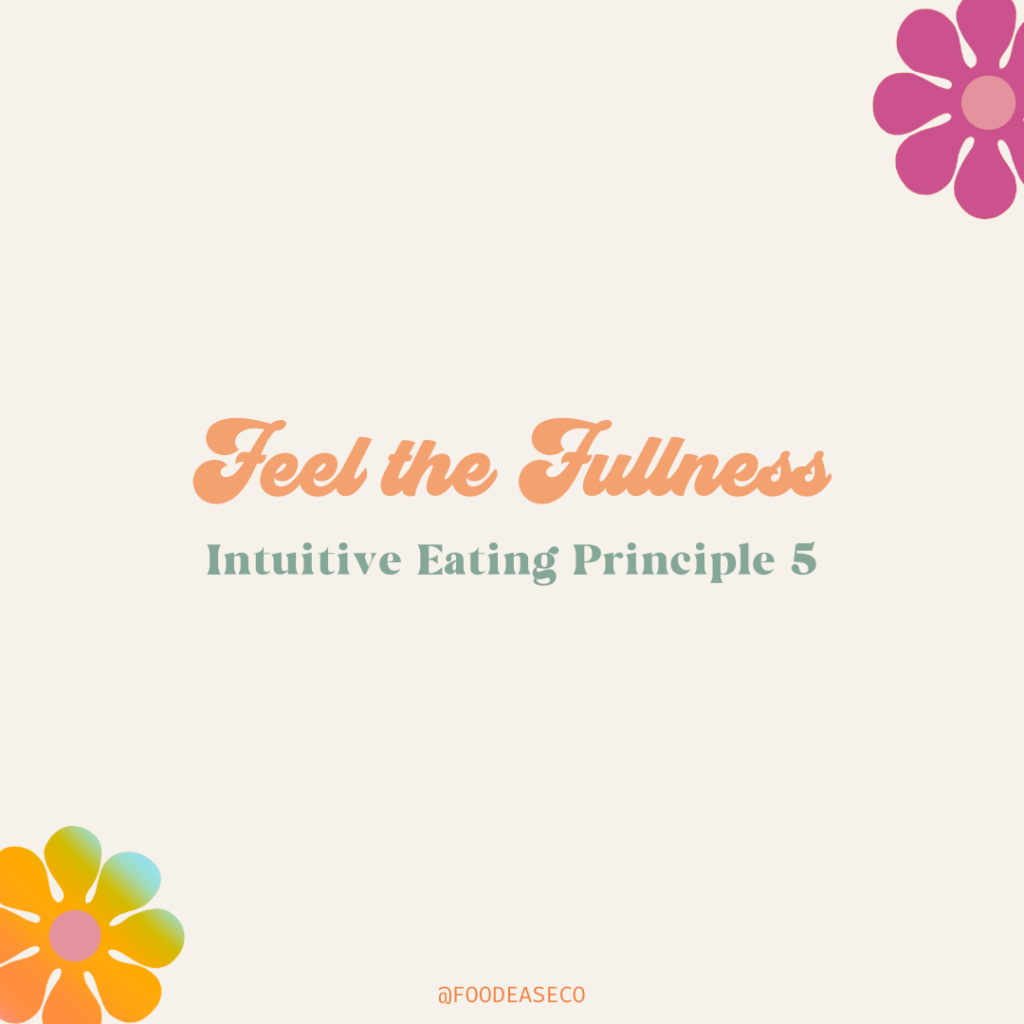Intuitive Eating Principle 5: Feel the Fullness

Introduction
As we slowly allow full permission to eat, food can be really exciting. Some misconceptions around Intuitive Eating are that you can eat whatever you want, whenever you want.
That simply isn’t true because it doesn’t take into account hunger cues, which we’ll take a deeper dive into today.
Feeling fullness is a practice. It is NORMAL to eat beyond fullness. It is also NORMAL to engage in distracted eating (hey-eating in front of the TV can be FUN after a long day).
Back to Basics
Do you know what feeling “comfortably full” feels like? Do you stop eating when you reach that place?
We’ve had a lot of mixed messaging over the years of being told when we “should” be full. This can look like:
· The “clean-plate club.” My mom called this the “happy-plate club,” but nonetheless I think we’re all familiar with the common dinner time rule growing up: no dessert until we finish everything on our dinner plate.
· Counting calories. Maybe you spent a lot of time tracking calories and when your calories “ran out” an external source told you: You should be full and done eating for the day. Is anyone ever really “full” after eating 1200 calories in a day?? The answer to that is a big fat NO.
Diving back into eating to fullness can be scary, especially when we’ve been told we should suppress hunger to be successful at a certain diet. Dieting leads to distrust around our body and our body cues.
Let’s Re-acquaint Ourselves with Hunger: Fullness is Your Friend!
Fullness is a satisfying feeling that allows us to rebuild our relationship with food, our body, and find peace around food in general (more on making peace with food here).
When we stop labeling foods as “good” and “bad” and just eat the dang food, we reduce charge around that food and know we can have that food at anytime. The urges to binge on that previously restricted food go away and you’re free to stop eating when you feel full.
Putting it into Practice
Being aware of hunger before, during, and after a meal will give you valuable information that will guide your next eating experience.
Try using the hunger/fullness scale and assign a number to those hunger cues and practice this:
1. Check in before the meal with a number on the scale, a feeling, and a goal for the meal.
2. Pause in the middle of your snack or meal and as yourself where your hunger is after a few bites. Be open to any answer as the whole point of this exercise is to honor hunger and find that satisfied feeling. Don’t judge the amount of food you’re eating or the number you assign to that feeling, this is all a learning process.
3. When you complete the meal, complete the check in process and “check out” of your meal. Did you reach that comfortably full feeling? Did you get distracted and eat past it?
I realize this sounds a lot like “mindful eating,” and it is, but don’t let that turn you off.
I was always really averse to practicing mindful eating in school because I’d have long days out of the house, often restricting food. When I’d get home I’d zone out in front of the TV with food. It was the only way I knew how to decompress at the time and every mention of “mindful eating” in school made me cringe.
Now I realize I was just really hungry, stressed, and sleep deprived, but I’m still not telling you that you have to let go of TV time while eating if it’s something you enjoy. Just evaluate WHY you’re doing it and how you’re feeling during the process. It’s still my favorite way to eat.
I love Evelyn Tribole’s (author of Intuitive Eating) 3-bite option when sitting for an entire meal without distractions is impossible (seems like always):
· First bite check in: note how you feel-pleasant, unpleasant, neutral
· Pause after another bite in the middle of the meal: how’s the taste of the food? Any emerging fullness?
· Rate your fullness during your last bite of food: pleasant, unpleasant, or neutral?
Use each opportunity to gather data on your mealtime feelings and habits. Again, intuitive Eating is a process, not a linear roadmap to food freedom. With practice, you’ll get to know your hunger cues really well.
Feeling fullness requires patience, practice, and intention, so be kind to yourself! Check back next week for the next principle: finding the satisfaction factor.
Have a Question?


Do you have any questions or suggestions? Feel free to contact us! Just leave your email here, and we will get back to you shortly.
